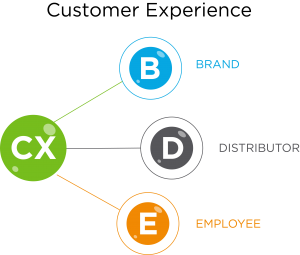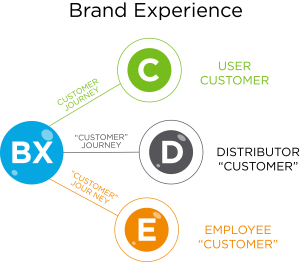“Understanding the difference between Customer Experience (CX) and Brand Experience (BX) is important because each has its own distinct impacts on the business strategy of an organization.”
Many customer-centric organizations think of their “customers” as end users, so they emphasize investments on delighting those segments. While striving to delight end users is essential, as a sole focus it can cause stress among the various functional areas of an organization and its leadership. As precious resources are allocated to end-user customers, unrecognized areas of great potential within the organization and its distribution channels may be overlooked.

In contrast, the brand-driven organization expands its view of “customers” beyond users to include its own employees and channel intermediaries. Why? Because these additional segments support the brand’s delivery to end users (product, availability, customer experience, service, etc.). As these “non-user customers” are immersed in the BX, efficiencies are often enhanced and greater authenticity resonates with users, which in turn enhances financial results.

So it makes sense that ensuring a unified brand experience for all internal, intermediary, and external “customer” segments can provide enhanced business efficiencies. When executed as a business process versus disparate campaigns, the BX approach can result in consistently higher profit margins from increased loyalty.
This focus on a BX shared among everyone who creates or consumes a brand can create a rare kind of “brand transparency” that few organizations have been able to achieve. Disney, Virgin, and Starbucks are among those few. The brand experience permeates these organizations and as a result is displayed in almost every aspect of employees’ behavior and ethic. This intimacy with a brand increases trust and brand relationship strength that fends off competition. In essence, investing in the total BX shifts resources from reactive to proactive, which can be associated with market leadership.
In some cases, even suppliers are considered to be customers, because as depicted in Porter’s Five Forces, suppliers often exert pressures on an organization (brand), which can be controlled to an extent by relationship management.
This perspective is not to imply that the brand itself is the center of the universe, but rather the EXPERIENCE each customer has in his/her relationship with the brand. Each Customer Experience (CX)—whether the “customer” is internal, intermediary, or external—is the path that leads to the ideal Brand Experience (BX) and better business results.
Contact GroPartners Consulting to find out more about how your organization can shift to a true Brand Experience orientation through a proven step-by-step process.

Recent Comments